Sociology Research Proposal: Gender Inequality and Domestic Violence
VerifiedAdded on 2022/12/28
|12
|2896
|28
Report
AI Summary
This research proposal examines the influence of gender inequality on violent attitudes of men towards women in domestic violence situations. The study, framed within a sociological context, investigates the research question: "Is gender inequality leading to male violence towards women in domestic violence?" The proposal outlines the research aim to develop a coherent understanding of this influence, with objectives including understanding gender inequality in societal structures, examining its impact on men's violent attitudes, evaluating the correlation between gender inequality and domestic violence, and suggesting activities to reduce inequality and violence. The research justifies its importance by highlighting its potential to develop insights into the causes of violence, guide future research, and inform policies. It includes a preliminary literature review, theoretical frameworks (Feminist theory and social-psychological theories), research methods (secondary data analysis of peer-reviewed journals, government reports, and WHO surveys), an explanatory research design, and ethical considerations, all contributing to a comprehensive understanding of the complex relationship between gender inequality and domestic violence. The study aims to contribute to a more equitable and violence-free society.
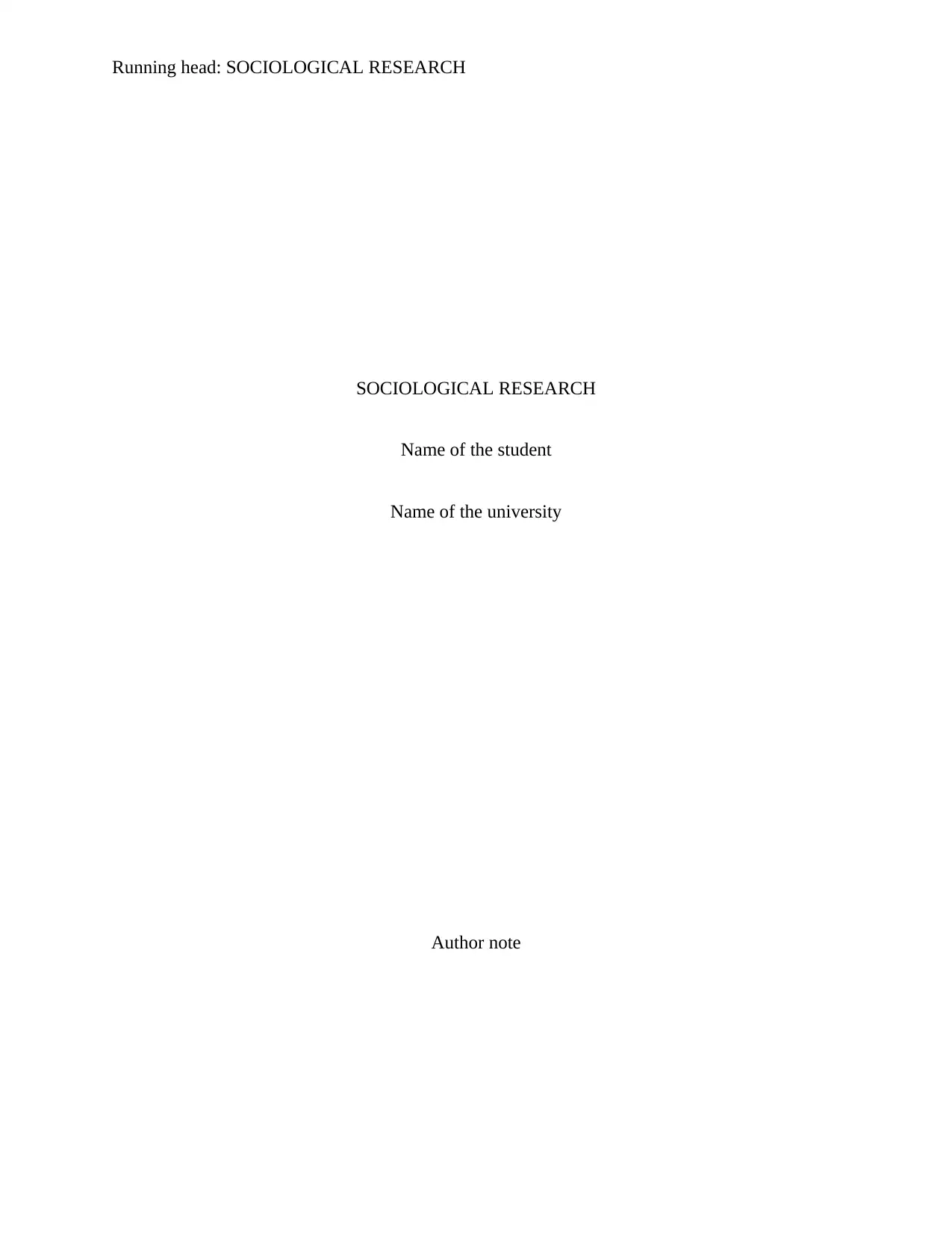
Running head: SOCIOLOGICAL RESEARCH
SOCIOLOGICAL RESEARCH
Name of the student
Name of the university
Author note
SOCIOLOGICAL RESEARCH
Name of the student
Name of the university
Author note
Paraphrase This Document
Need a fresh take? Get an instant paraphrase of this document with our AI Paraphraser
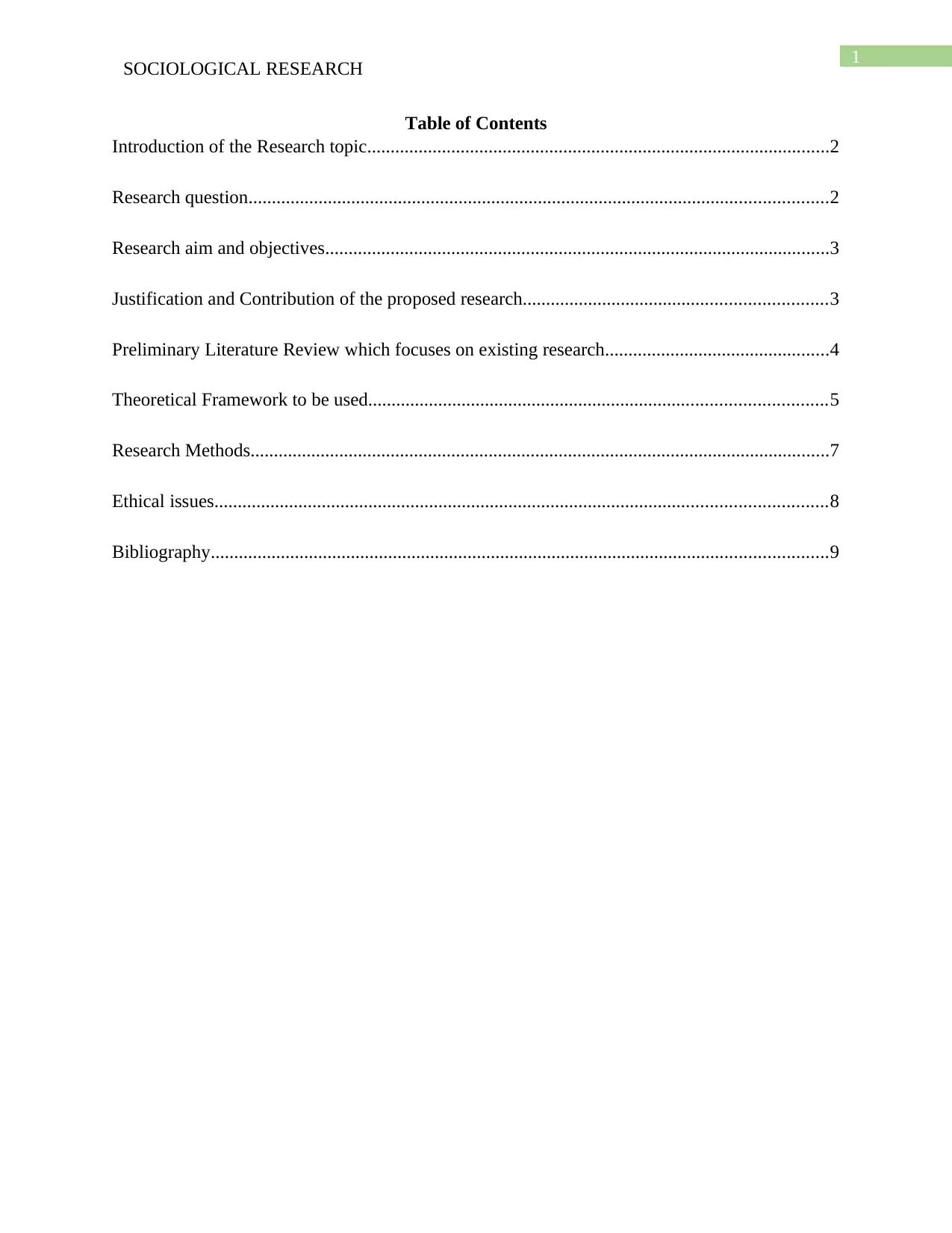
1
SOCIOLOGICAL RESEARCH
Table of Contents
Introduction of the Research topic...................................................................................................2
Research question............................................................................................................................2
Research aim and objectives............................................................................................................3
Justification and Contribution of the proposed research.................................................................3
Preliminary Literature Review which focuses on existing research................................................4
Theoretical Framework to be used..................................................................................................5
Research Methods............................................................................................................................7
Ethical issues...................................................................................................................................8
Bibliography....................................................................................................................................9
SOCIOLOGICAL RESEARCH
Table of Contents
Introduction of the Research topic...................................................................................................2
Research question............................................................................................................................2
Research aim and objectives............................................................................................................3
Justification and Contribution of the proposed research.................................................................3
Preliminary Literature Review which focuses on existing research................................................4
Theoretical Framework to be used..................................................................................................5
Research Methods............................................................................................................................7
Ethical issues...................................................................................................................................8
Bibliography....................................................................................................................................9
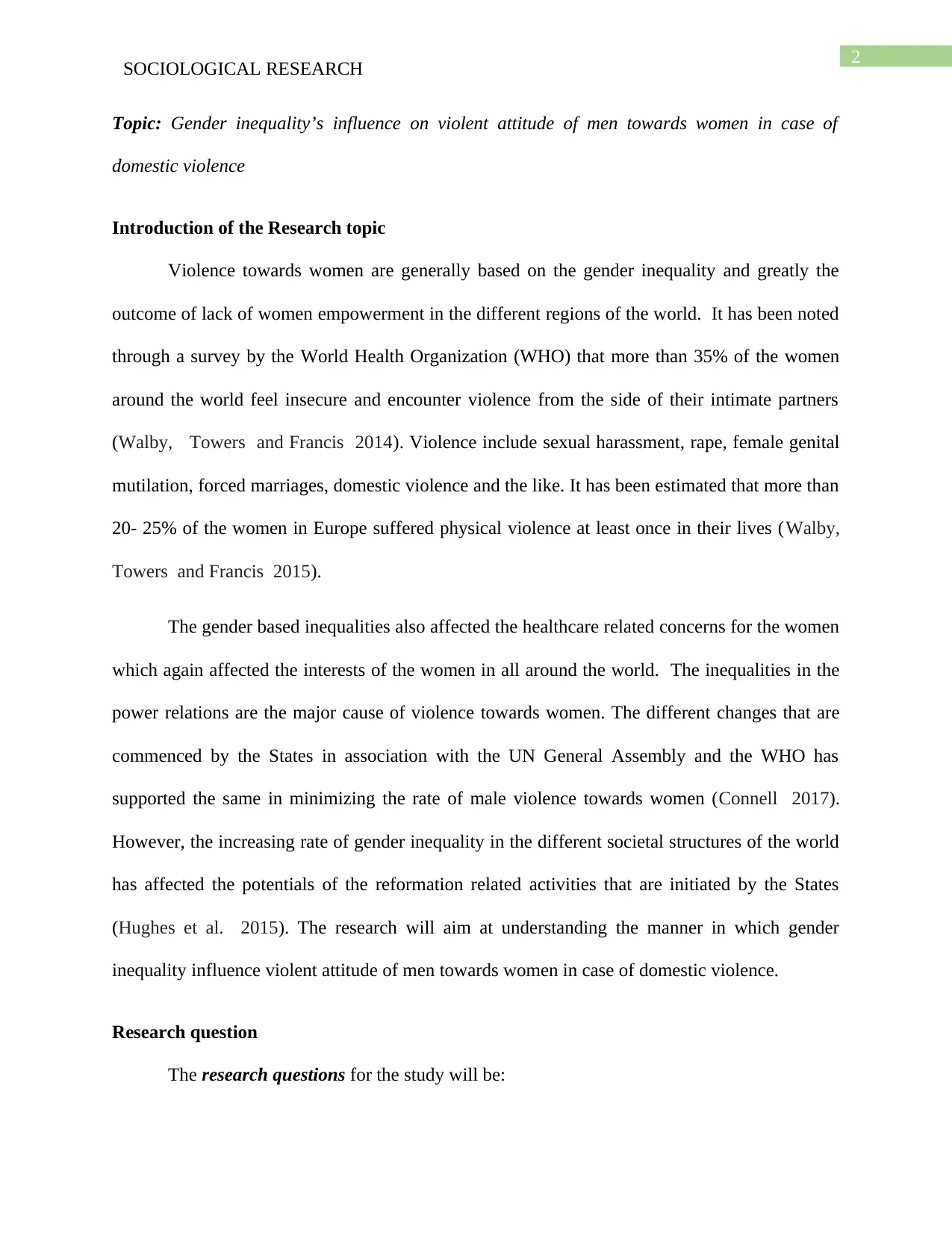
2
SOCIOLOGICAL RESEARCH
Topic: Gender inequality’s influence on violent attitude of men towards women in case of
domestic violence
Introduction of the Research topic
Violence towards women are generally based on the gender inequality and greatly the
outcome of lack of women empowerment in the different regions of the world. It has been noted
through a survey by the World Health Organization (WHO) that more than 35% of the women
around the world feel insecure and encounter violence from the side of their intimate partners
(Walby, Towers and Francis 2014). Violence include sexual harassment, rape, female genital
mutilation, forced marriages, domestic violence and the like. It has been estimated that more than
20- 25% of the women in Europe suffered physical violence at least once in their lives (Walby,
Towers and Francis 2015).
The gender based inequalities also affected the healthcare related concerns for the women
which again affected the interests of the women in all around the world. The inequalities in the
power relations are the major cause of violence towards women. The different changes that are
commenced by the States in association with the UN General Assembly and the WHO has
supported the same in minimizing the rate of male violence towards women (Connell 2017).
However, the increasing rate of gender inequality in the different societal structures of the world
has affected the potentials of the reformation related activities that are initiated by the States
(Hughes et al. 2015). The research will aim at understanding the manner in which gender
inequality influence violent attitude of men towards women in case of domestic violence.
Research question
The research questions for the study will be:
SOCIOLOGICAL RESEARCH
Topic: Gender inequality’s influence on violent attitude of men towards women in case of
domestic violence
Introduction of the Research topic
Violence towards women are generally based on the gender inequality and greatly the
outcome of lack of women empowerment in the different regions of the world. It has been noted
through a survey by the World Health Organization (WHO) that more than 35% of the women
around the world feel insecure and encounter violence from the side of their intimate partners
(Walby, Towers and Francis 2014). Violence include sexual harassment, rape, female genital
mutilation, forced marriages, domestic violence and the like. It has been estimated that more than
20- 25% of the women in Europe suffered physical violence at least once in their lives (Walby,
Towers and Francis 2015).
The gender based inequalities also affected the healthcare related concerns for the women
which again affected the interests of the women in all around the world. The inequalities in the
power relations are the major cause of violence towards women. The different changes that are
commenced by the States in association with the UN General Assembly and the WHO has
supported the same in minimizing the rate of male violence towards women (Connell 2017).
However, the increasing rate of gender inequality in the different societal structures of the world
has affected the potentials of the reformation related activities that are initiated by the States
(Hughes et al. 2015). The research will aim at understanding the manner in which gender
inequality influence violent attitude of men towards women in case of domestic violence.
Research question
The research questions for the study will be:
⊘ This is a preview!⊘
Do you want full access?
Subscribe today to unlock all pages.

Trusted by 1+ million students worldwide
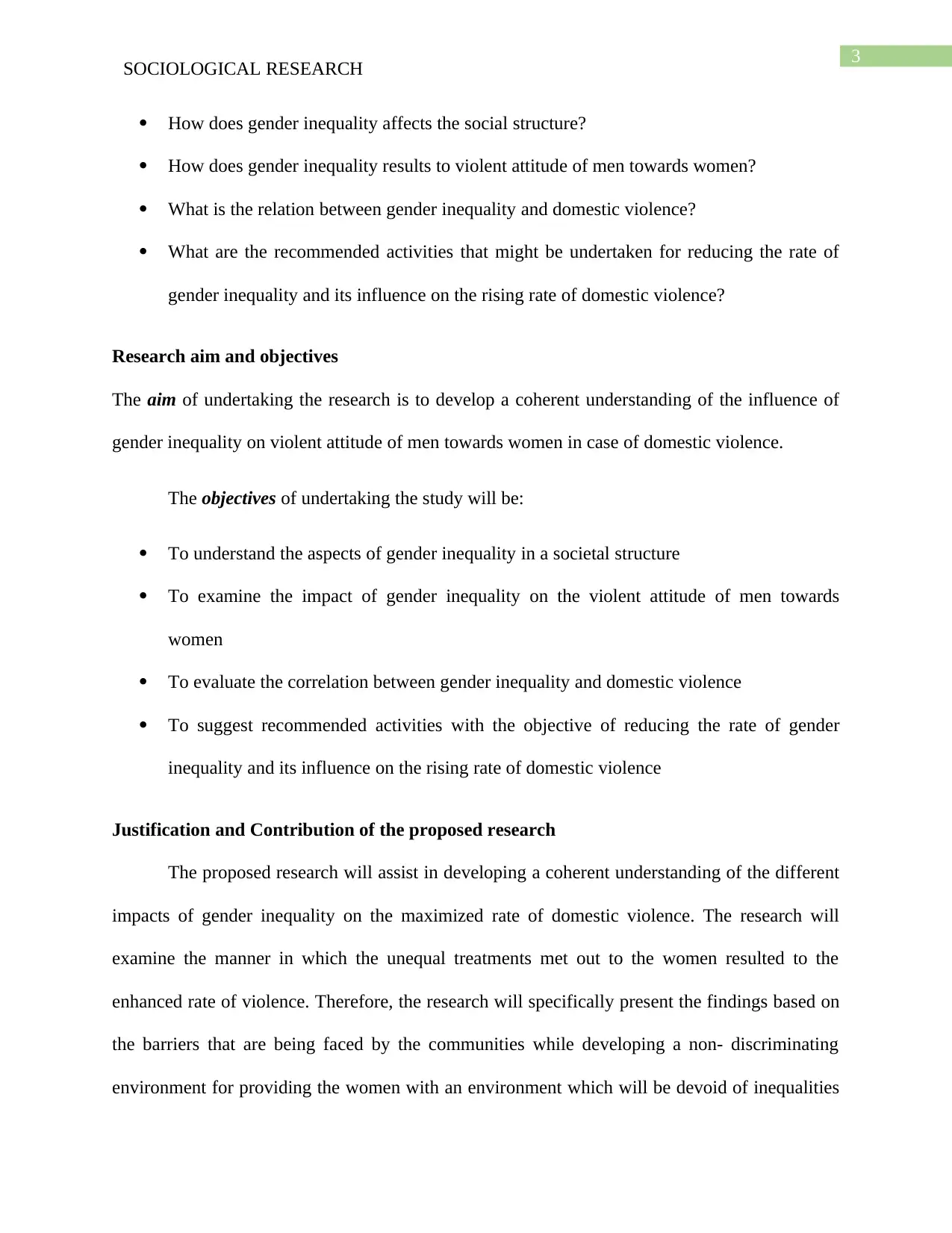
3
SOCIOLOGICAL RESEARCH
How does gender inequality affects the social structure?
How does gender inequality results to violent attitude of men towards women?
What is the relation between gender inequality and domestic violence?
What are the recommended activities that might be undertaken for reducing the rate of
gender inequality and its influence on the rising rate of domestic violence?
Research aim and objectives
The aim of undertaking the research is to develop a coherent understanding of the influence of
gender inequality on violent attitude of men towards women in case of domestic violence.
The objectives of undertaking the study will be:
To understand the aspects of gender inequality in a societal structure
To examine the impact of gender inequality on the violent attitude of men towards
women
To evaluate the correlation between gender inequality and domestic violence
To suggest recommended activities with the objective of reducing the rate of gender
inequality and its influence on the rising rate of domestic violence
Justification and Contribution of the proposed research
The proposed research will assist in developing a coherent understanding of the different
impacts of gender inequality on the maximized rate of domestic violence. The research will
examine the manner in which the unequal treatments met out to the women resulted to the
enhanced rate of violence. Therefore, the research will specifically present the findings based on
the barriers that are being faced by the communities while developing a non- discriminating
environment for providing the women with an environment which will be devoid of inequalities
SOCIOLOGICAL RESEARCH
How does gender inequality affects the social structure?
How does gender inequality results to violent attitude of men towards women?
What is the relation between gender inequality and domestic violence?
What are the recommended activities that might be undertaken for reducing the rate of
gender inequality and its influence on the rising rate of domestic violence?
Research aim and objectives
The aim of undertaking the research is to develop a coherent understanding of the influence of
gender inequality on violent attitude of men towards women in case of domestic violence.
The objectives of undertaking the study will be:
To understand the aspects of gender inequality in a societal structure
To examine the impact of gender inequality on the violent attitude of men towards
women
To evaluate the correlation between gender inequality and domestic violence
To suggest recommended activities with the objective of reducing the rate of gender
inequality and its influence on the rising rate of domestic violence
Justification and Contribution of the proposed research
The proposed research will assist in developing a coherent understanding of the different
impacts of gender inequality on the maximized rate of domestic violence. The research will
examine the manner in which the unequal treatments met out to the women resulted to the
enhanced rate of violence. Therefore, the research will specifically present the findings based on
the barriers that are being faced by the communities while developing a non- discriminating
environment for providing the women with an environment which will be devoid of inequalities
Paraphrase This Document
Need a fresh take? Get an instant paraphrase of this document with our AI Paraphraser
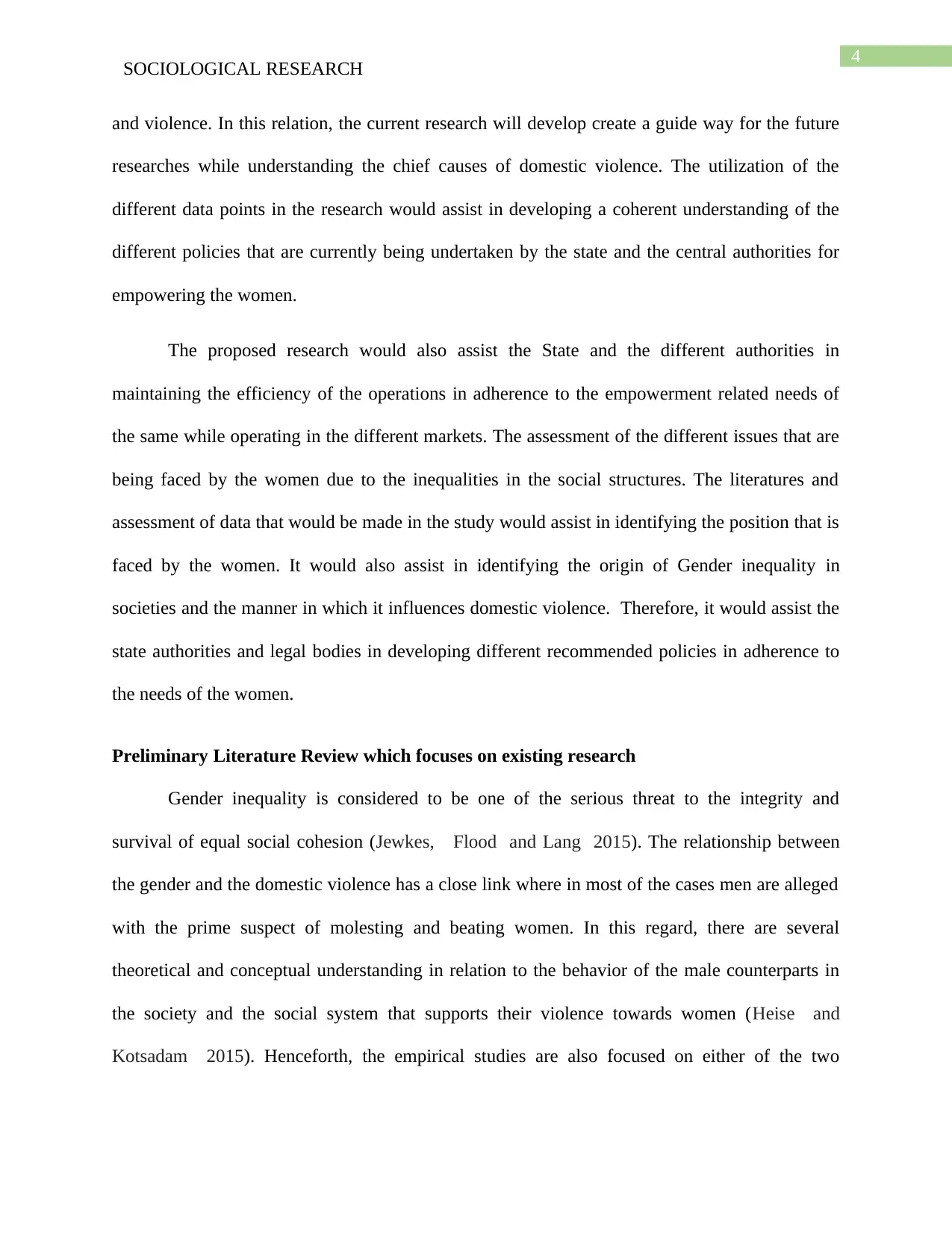
4
SOCIOLOGICAL RESEARCH
and violence. In this relation, the current research will develop create a guide way for the future
researches while understanding the chief causes of domestic violence. The utilization of the
different data points in the research would assist in developing a coherent understanding of the
different policies that are currently being undertaken by the state and the central authorities for
empowering the women.
The proposed research would also assist the State and the different authorities in
maintaining the efficiency of the operations in adherence to the empowerment related needs of
the same while operating in the different markets. The assessment of the different issues that are
being faced by the women due to the inequalities in the social structures. The literatures and
assessment of data that would be made in the study would assist in identifying the position that is
faced by the women. It would also assist in identifying the origin of Gender inequality in
societies and the manner in which it influences domestic violence. Therefore, it would assist the
state authorities and legal bodies in developing different recommended policies in adherence to
the needs of the women.
Preliminary Literature Review which focuses on existing research
Gender inequality is considered to be one of the serious threat to the integrity and
survival of equal social cohesion (Jewkes, Flood and Lang 2015). The relationship between
the gender and the domestic violence has a close link where in most of the cases men are alleged
with the prime suspect of molesting and beating women. In this regard, there are several
theoretical and conceptual understanding in relation to the behavior of the male counterparts in
the society and the social system that supports their violence towards women (Heise and
Kotsadam 2015). Henceforth, the empirical studies are also focused on either of the two
SOCIOLOGICAL RESEARCH
and violence. In this relation, the current research will develop create a guide way for the future
researches while understanding the chief causes of domestic violence. The utilization of the
different data points in the research would assist in developing a coherent understanding of the
different policies that are currently being undertaken by the state and the central authorities for
empowering the women.
The proposed research would also assist the State and the different authorities in
maintaining the efficiency of the operations in adherence to the empowerment related needs of
the same while operating in the different markets. The assessment of the different issues that are
being faced by the women due to the inequalities in the social structures. The literatures and
assessment of data that would be made in the study would assist in identifying the position that is
faced by the women. It would also assist in identifying the origin of Gender inequality in
societies and the manner in which it influences domestic violence. Therefore, it would assist the
state authorities and legal bodies in developing different recommended policies in adherence to
the needs of the women.
Preliminary Literature Review which focuses on existing research
Gender inequality is considered to be one of the serious threat to the integrity and
survival of equal social cohesion (Jewkes, Flood and Lang 2015). The relationship between
the gender and the domestic violence has a close link where in most of the cases men are alleged
with the prime suspect of molesting and beating women. In this regard, there are several
theoretical and conceptual understanding in relation to the behavior of the male counterparts in
the society and the social system that supports their violence towards women (Heise and
Kotsadam 2015). Henceforth, the empirical studies are also focused on either of the two
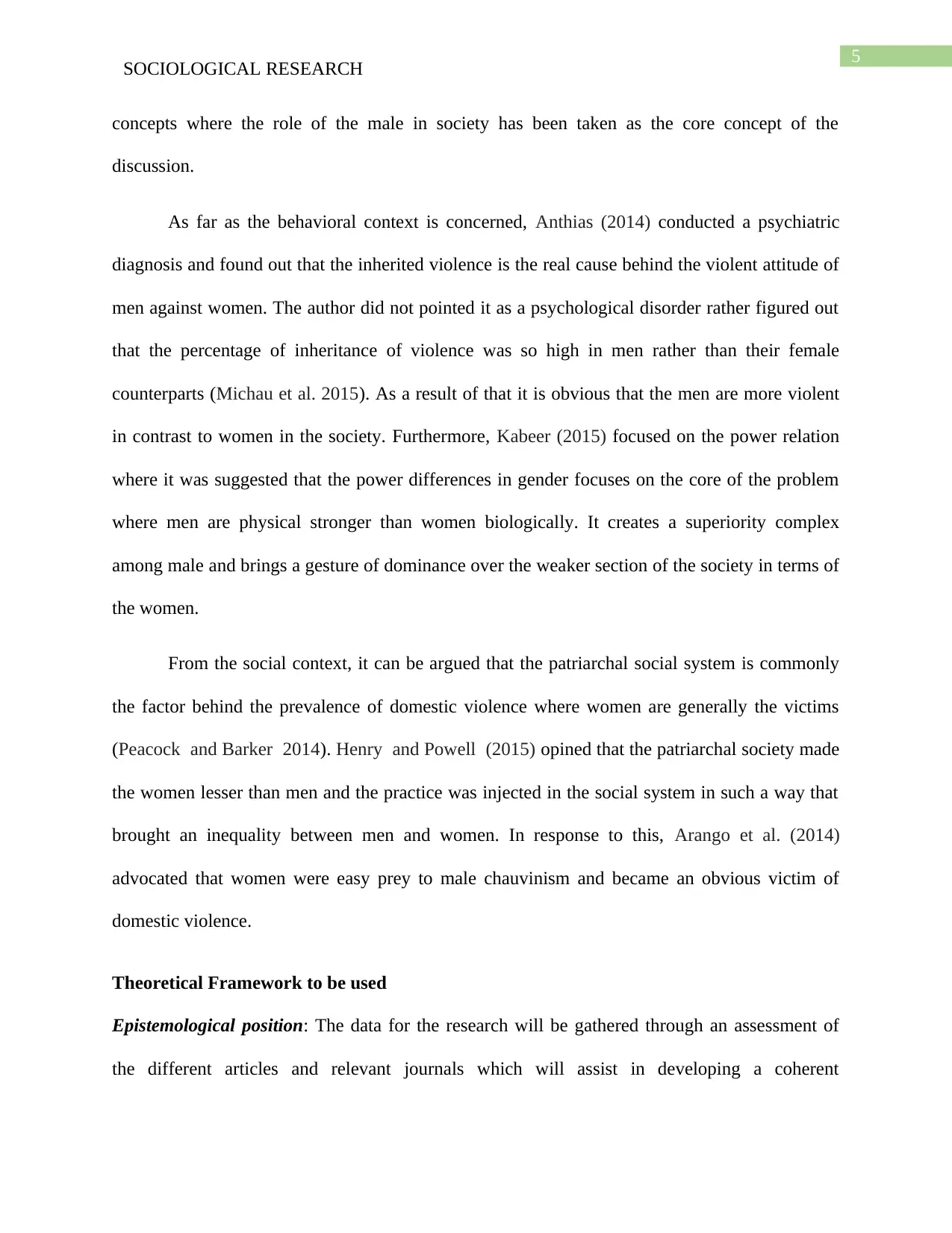
5
SOCIOLOGICAL RESEARCH
concepts where the role of the male in society has been taken as the core concept of the
discussion.
As far as the behavioral context is concerned, Anthias (2014) conducted a psychiatric
diagnosis and found out that the inherited violence is the real cause behind the violent attitude of
men against women. The author did not pointed it as a psychological disorder rather figured out
that the percentage of inheritance of violence was so high in men rather than their female
counterparts (Michau et al. 2015). As a result of that it is obvious that the men are more violent
in contrast to women in the society. Furthermore, Kabeer (2015) focused on the power relation
where it was suggested that the power differences in gender focuses on the core of the problem
where men are physical stronger than women biologically. It creates a superiority complex
among male and brings a gesture of dominance over the weaker section of the society in terms of
the women.
From the social context, it can be argued that the patriarchal social system is commonly
the factor behind the prevalence of domestic violence where women are generally the victims
(Peacock and Barker 2014). Henry and Powell (2015) opined that the patriarchal society made
the women lesser than men and the practice was injected in the social system in such a way that
brought an inequality between men and women. In response to this, Arango et al. (2014)
advocated that women were easy prey to male chauvinism and became an obvious victim of
domestic violence.
Theoretical Framework to be used
Epistemological position: The data for the research will be gathered through an assessment of
the different articles and relevant journals which will assist in developing a coherent
SOCIOLOGICAL RESEARCH
concepts where the role of the male in society has been taken as the core concept of the
discussion.
As far as the behavioral context is concerned, Anthias (2014) conducted a psychiatric
diagnosis and found out that the inherited violence is the real cause behind the violent attitude of
men against women. The author did not pointed it as a psychological disorder rather figured out
that the percentage of inheritance of violence was so high in men rather than their female
counterparts (Michau et al. 2015). As a result of that it is obvious that the men are more violent
in contrast to women in the society. Furthermore, Kabeer (2015) focused on the power relation
where it was suggested that the power differences in gender focuses on the core of the problem
where men are physical stronger than women biologically. It creates a superiority complex
among male and brings a gesture of dominance over the weaker section of the society in terms of
the women.
From the social context, it can be argued that the patriarchal social system is commonly
the factor behind the prevalence of domestic violence where women are generally the victims
(Peacock and Barker 2014). Henry and Powell (2015) opined that the patriarchal society made
the women lesser than men and the practice was injected in the social system in such a way that
brought an inequality between men and women. In response to this, Arango et al. (2014)
advocated that women were easy prey to male chauvinism and became an obvious victim of
domestic violence.
Theoretical Framework to be used
Epistemological position: The data for the research will be gathered through an assessment of
the different articles and relevant journals which will assist in developing a coherent
⊘ This is a preview!⊘
Do you want full access?
Subscribe today to unlock all pages.

Trusted by 1+ million students worldwide
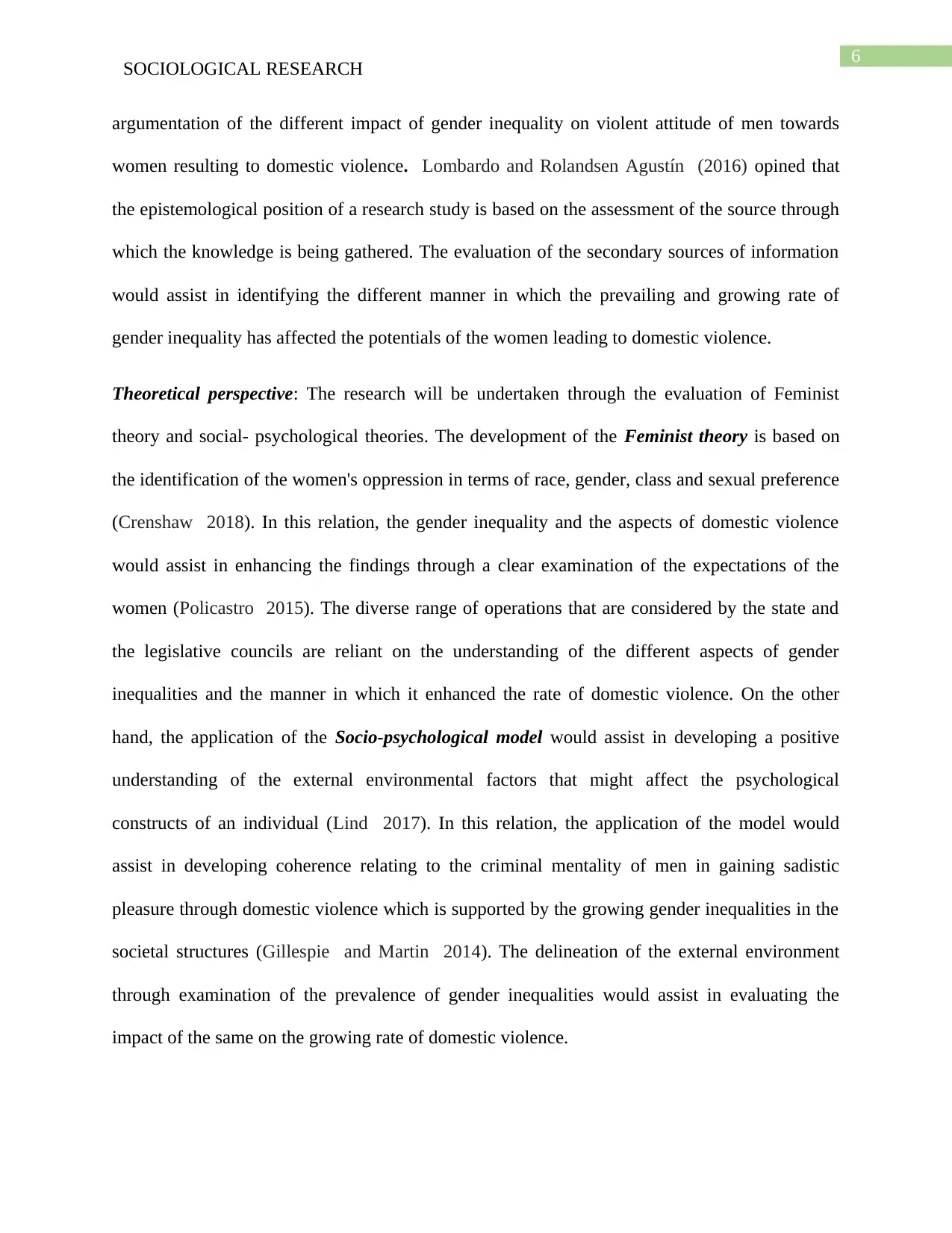
6
SOCIOLOGICAL RESEARCH
argumentation of the different impact of gender inequality on violent attitude of men towards
women resulting to domestic violence. Lombardo and Rolandsen Agustín (2016) opined that
the epistemological position of a research study is based on the assessment of the source through
which the knowledge is being gathered. The evaluation of the secondary sources of information
would assist in identifying the different manner in which the prevailing and growing rate of
gender inequality has affected the potentials of the women leading to domestic violence.
Theoretical perspective: The research will be undertaken through the evaluation of Feminist
theory and social- psychological theories. The development of the Feminist theory is based on
the identification of the women's oppression in terms of race, gender, class and sexual preference
(Crenshaw 2018). In this relation, the gender inequality and the aspects of domestic violence
would assist in enhancing the findings through a clear examination of the expectations of the
women (Policastro 2015). The diverse range of operations that are considered by the state and
the legislative councils are reliant on the understanding of the different aspects of gender
inequalities and the manner in which it enhanced the rate of domestic violence. On the other
hand, the application of the Socio-psychological model would assist in developing a positive
understanding of the external environmental factors that might affect the psychological
constructs of an individual (Lind 2017). In this relation, the application of the model would
assist in developing coherence relating to the criminal mentality of men in gaining sadistic
pleasure through domestic violence which is supported by the growing gender inequalities in the
societal structures (Gillespie and Martin 2014). The delineation of the external environment
through examination of the prevalence of gender inequalities would assist in evaluating the
impact of the same on the growing rate of domestic violence.
SOCIOLOGICAL RESEARCH
argumentation of the different impact of gender inequality on violent attitude of men towards
women resulting to domestic violence. Lombardo and Rolandsen Agustín (2016) opined that
the epistemological position of a research study is based on the assessment of the source through
which the knowledge is being gathered. The evaluation of the secondary sources of information
would assist in identifying the different manner in which the prevailing and growing rate of
gender inequality has affected the potentials of the women leading to domestic violence.
Theoretical perspective: The research will be undertaken through the evaluation of Feminist
theory and social- psychological theories. The development of the Feminist theory is based on
the identification of the women's oppression in terms of race, gender, class and sexual preference
(Crenshaw 2018). In this relation, the gender inequality and the aspects of domestic violence
would assist in enhancing the findings through a clear examination of the expectations of the
women (Policastro 2015). The diverse range of operations that are considered by the state and
the legislative councils are reliant on the understanding of the different aspects of gender
inequalities and the manner in which it enhanced the rate of domestic violence. On the other
hand, the application of the Socio-psychological model would assist in developing a positive
understanding of the external environmental factors that might affect the psychological
constructs of an individual (Lind 2017). In this relation, the application of the model would
assist in developing coherence relating to the criminal mentality of men in gaining sadistic
pleasure through domestic violence which is supported by the growing gender inequalities in the
societal structures (Gillespie and Martin 2014). The delineation of the external environment
through examination of the prevalence of gender inequalities would assist in evaluating the
impact of the same on the growing rate of domestic violence.
Paraphrase This Document
Need a fresh take? Get an instant paraphrase of this document with our AI Paraphraser
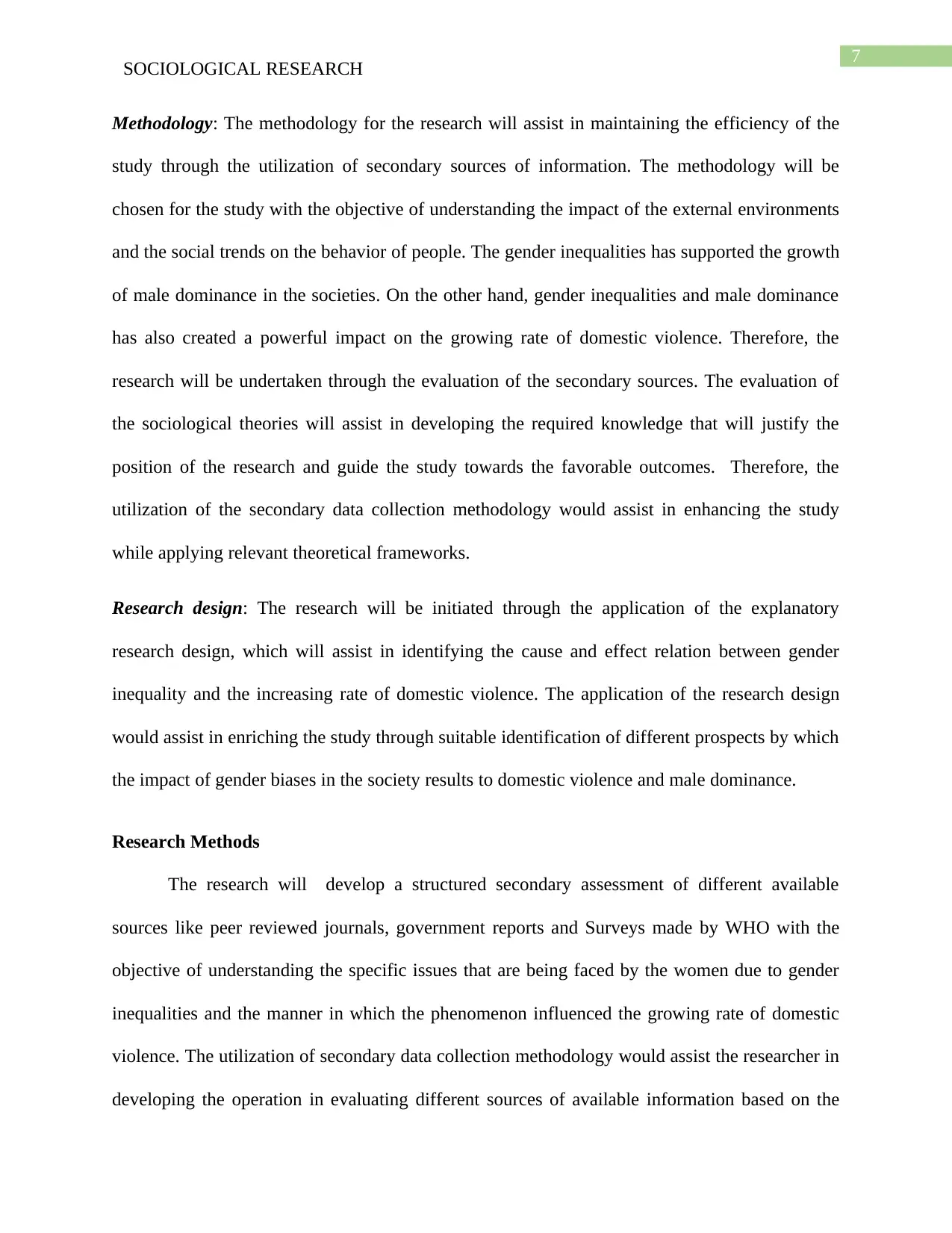
7
SOCIOLOGICAL RESEARCH
Methodology: The methodology for the research will assist in maintaining the efficiency of the
study through the utilization of secondary sources of information. The methodology will be
chosen for the study with the objective of understanding the impact of the external environments
and the social trends on the behavior of people. The gender inequalities has supported the growth
of male dominance in the societies. On the other hand, gender inequalities and male dominance
has also created a powerful impact on the growing rate of domestic violence. Therefore, the
research will be undertaken through the evaluation of the secondary sources. The evaluation of
the sociological theories will assist in developing the required knowledge that will justify the
position of the research and guide the study towards the favorable outcomes. Therefore, the
utilization of the secondary data collection methodology would assist in enhancing the study
while applying relevant theoretical frameworks.
Research design: The research will be initiated through the application of the explanatory
research design, which will assist in identifying the cause and effect relation between gender
inequality and the increasing rate of domestic violence. The application of the research design
would assist in enriching the study through suitable identification of different prospects by which
the impact of gender biases in the society results to domestic violence and male dominance.
Research Methods
The research will develop a structured secondary assessment of different available
sources like peer reviewed journals, government reports and Surveys made by WHO with the
objective of understanding the specific issues that are being faced by the women due to gender
inequalities and the manner in which the phenomenon influenced the growing rate of domestic
violence. The utilization of secondary data collection methodology would assist the researcher in
developing the operation in evaluating different sources of available information based on the
SOCIOLOGICAL RESEARCH
Methodology: The methodology for the research will assist in maintaining the efficiency of the
study through the utilization of secondary sources of information. The methodology will be
chosen for the study with the objective of understanding the impact of the external environments
and the social trends on the behavior of people. The gender inequalities has supported the growth
of male dominance in the societies. On the other hand, gender inequalities and male dominance
has also created a powerful impact on the growing rate of domestic violence. Therefore, the
research will be undertaken through the evaluation of the secondary sources. The evaluation of
the sociological theories will assist in developing the required knowledge that will justify the
position of the research and guide the study towards the favorable outcomes. Therefore, the
utilization of the secondary data collection methodology would assist in enhancing the study
while applying relevant theoretical frameworks.
Research design: The research will be initiated through the application of the explanatory
research design, which will assist in identifying the cause and effect relation between gender
inequality and the increasing rate of domestic violence. The application of the research design
would assist in enriching the study through suitable identification of different prospects by which
the impact of gender biases in the society results to domestic violence and male dominance.
Research Methods
The research will develop a structured secondary assessment of different available
sources like peer reviewed journals, government reports and Surveys made by WHO with the
objective of understanding the specific issues that are being faced by the women due to gender
inequalities and the manner in which the phenomenon influenced the growing rate of domestic
violence. The utilization of secondary data collection methodology would assist the researcher in
developing the operation in evaluating different sources of available information based on the
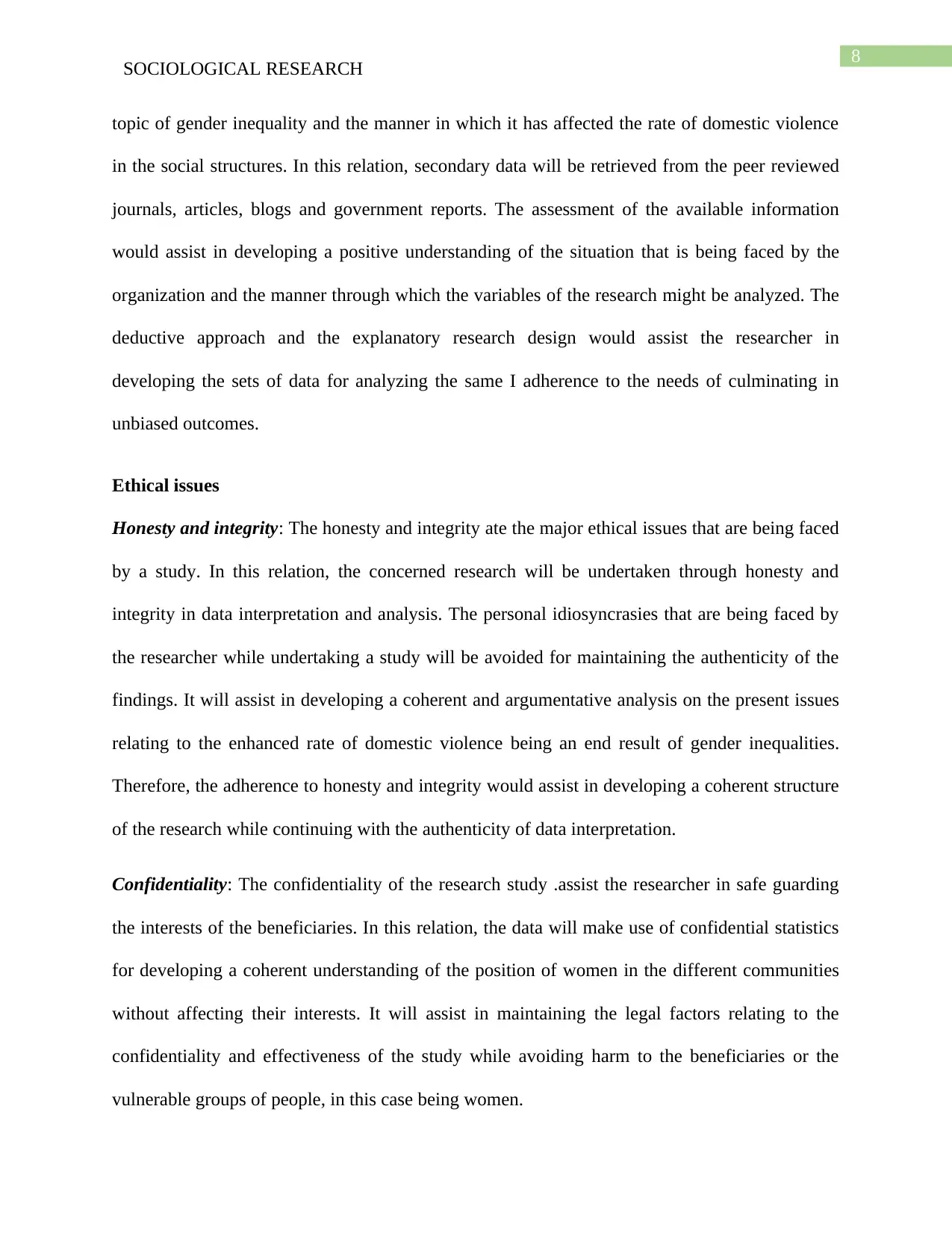
8
SOCIOLOGICAL RESEARCH
topic of gender inequality and the manner in which it has affected the rate of domestic violence
in the social structures. In this relation, secondary data will be retrieved from the peer reviewed
journals, articles, blogs and government reports. The assessment of the available information
would assist in developing a positive understanding of the situation that is being faced by the
organization and the manner through which the variables of the research might be analyzed. The
deductive approach and the explanatory research design would assist the researcher in
developing the sets of data for analyzing the same I adherence to the needs of culminating in
unbiased outcomes.
Ethical issues
Honesty and integrity: The honesty and integrity ate the major ethical issues that are being faced
by a study. In this relation, the concerned research will be undertaken through honesty and
integrity in data interpretation and analysis. The personal idiosyncrasies that are being faced by
the researcher while undertaking a study will be avoided for maintaining the authenticity of the
findings. It will assist in developing a coherent and argumentative analysis on the present issues
relating to the enhanced rate of domestic violence being an end result of gender inequalities.
Therefore, the adherence to honesty and integrity would assist in developing a coherent structure
of the research while continuing with the authenticity of data interpretation.
Confidentiality: The confidentiality of the research study .assist the researcher in safe guarding
the interests of the beneficiaries. In this relation, the data will make use of confidential statistics
for developing a coherent understanding of the position of women in the different communities
without affecting their interests. It will assist in maintaining the legal factors relating to the
confidentiality and effectiveness of the study while avoiding harm to the beneficiaries or the
vulnerable groups of people, in this case being women.
SOCIOLOGICAL RESEARCH
topic of gender inequality and the manner in which it has affected the rate of domestic violence
in the social structures. In this relation, secondary data will be retrieved from the peer reviewed
journals, articles, blogs and government reports. The assessment of the available information
would assist in developing a positive understanding of the situation that is being faced by the
organization and the manner through which the variables of the research might be analyzed. The
deductive approach and the explanatory research design would assist the researcher in
developing the sets of data for analyzing the same I adherence to the needs of culminating in
unbiased outcomes.
Ethical issues
Honesty and integrity: The honesty and integrity ate the major ethical issues that are being faced
by a study. In this relation, the concerned research will be undertaken through honesty and
integrity in data interpretation and analysis. The personal idiosyncrasies that are being faced by
the researcher while undertaking a study will be avoided for maintaining the authenticity of the
findings. It will assist in developing a coherent and argumentative analysis on the present issues
relating to the enhanced rate of domestic violence being an end result of gender inequalities.
Therefore, the adherence to honesty and integrity would assist in developing a coherent structure
of the research while continuing with the authenticity of data interpretation.
Confidentiality: The confidentiality of the research study .assist the researcher in safe guarding
the interests of the beneficiaries. In this relation, the data will make use of confidential statistics
for developing a coherent understanding of the position of women in the different communities
without affecting their interests. It will assist in maintaining the legal factors relating to the
confidentiality and effectiveness of the study while avoiding harm to the beneficiaries or the
vulnerable groups of people, in this case being women.
⊘ This is a preview!⊘
Do you want full access?
Subscribe today to unlock all pages.

Trusted by 1+ million students worldwide

9
SOCIOLOGICAL RESEARCH
SOCIOLOGICAL RESEARCH
Paraphrase This Document
Need a fresh take? Get an instant paraphrase of this document with our AI Paraphraser
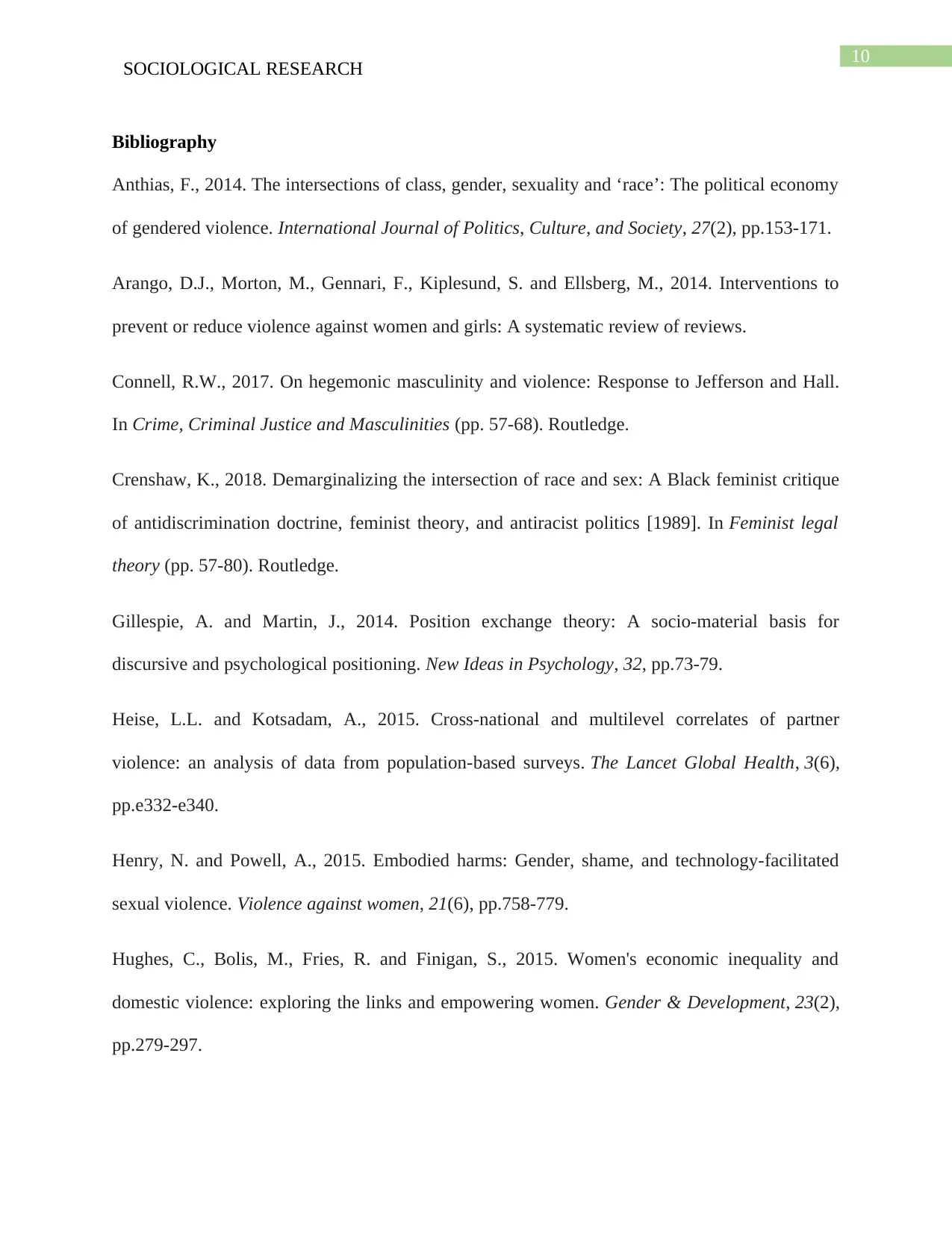
10
SOCIOLOGICAL RESEARCH
Bibliography
Anthias, F., 2014. The intersections of class, gender, sexuality and ‘race’: The political economy
of gendered violence. International Journal of Politics, Culture, and Society, 27(2), pp.153-171.
Arango, D.J., Morton, M., Gennari, F., Kiplesund, S. and Ellsberg, M., 2014. Interventions to
prevent or reduce violence against women and girls: A systematic review of reviews.
Connell, R.W., 2017. On hegemonic masculinity and violence: Response to Jefferson and Hall.
In Crime, Criminal Justice and Masculinities (pp. 57-68). Routledge.
Crenshaw, K., 2018. Demarginalizing the intersection of race and sex: A Black feminist critique
of antidiscrimination doctrine, feminist theory, and antiracist politics [1989]. In Feminist legal
theory (pp. 57-80). Routledge.
Gillespie, A. and Martin, J., 2014. Position exchange theory: A socio-material basis for
discursive and psychological positioning. New Ideas in Psychology, 32, pp.73-79.
Heise, L.L. and Kotsadam, A., 2015. Cross-national and multilevel correlates of partner
violence: an analysis of data from population-based surveys. The Lancet Global Health, 3(6),
pp.e332-e340.
Henry, N. and Powell, A., 2015. Embodied harms: Gender, shame, and technology-facilitated
sexual violence. Violence against women, 21(6), pp.758-779.
Hughes, C., Bolis, M., Fries, R. and Finigan, S., 2015. Women's economic inequality and
domestic violence: exploring the links and empowering women. Gender & Development, 23(2),
pp.279-297.
SOCIOLOGICAL RESEARCH
Bibliography
Anthias, F., 2014. The intersections of class, gender, sexuality and ‘race’: The political economy
of gendered violence. International Journal of Politics, Culture, and Society, 27(2), pp.153-171.
Arango, D.J., Morton, M., Gennari, F., Kiplesund, S. and Ellsberg, M., 2014. Interventions to
prevent or reduce violence against women and girls: A systematic review of reviews.
Connell, R.W., 2017. On hegemonic masculinity and violence: Response to Jefferson and Hall.
In Crime, Criminal Justice and Masculinities (pp. 57-68). Routledge.
Crenshaw, K., 2018. Demarginalizing the intersection of race and sex: A Black feminist critique
of antidiscrimination doctrine, feminist theory, and antiracist politics [1989]. In Feminist legal
theory (pp. 57-80). Routledge.
Gillespie, A. and Martin, J., 2014. Position exchange theory: A socio-material basis for
discursive and psychological positioning. New Ideas in Psychology, 32, pp.73-79.
Heise, L.L. and Kotsadam, A., 2015. Cross-national and multilevel correlates of partner
violence: an analysis of data from population-based surveys. The Lancet Global Health, 3(6),
pp.e332-e340.
Henry, N. and Powell, A., 2015. Embodied harms: Gender, shame, and technology-facilitated
sexual violence. Violence against women, 21(6), pp.758-779.
Hughes, C., Bolis, M., Fries, R. and Finigan, S., 2015. Women's economic inequality and
domestic violence: exploring the links and empowering women. Gender & Development, 23(2),
pp.279-297.
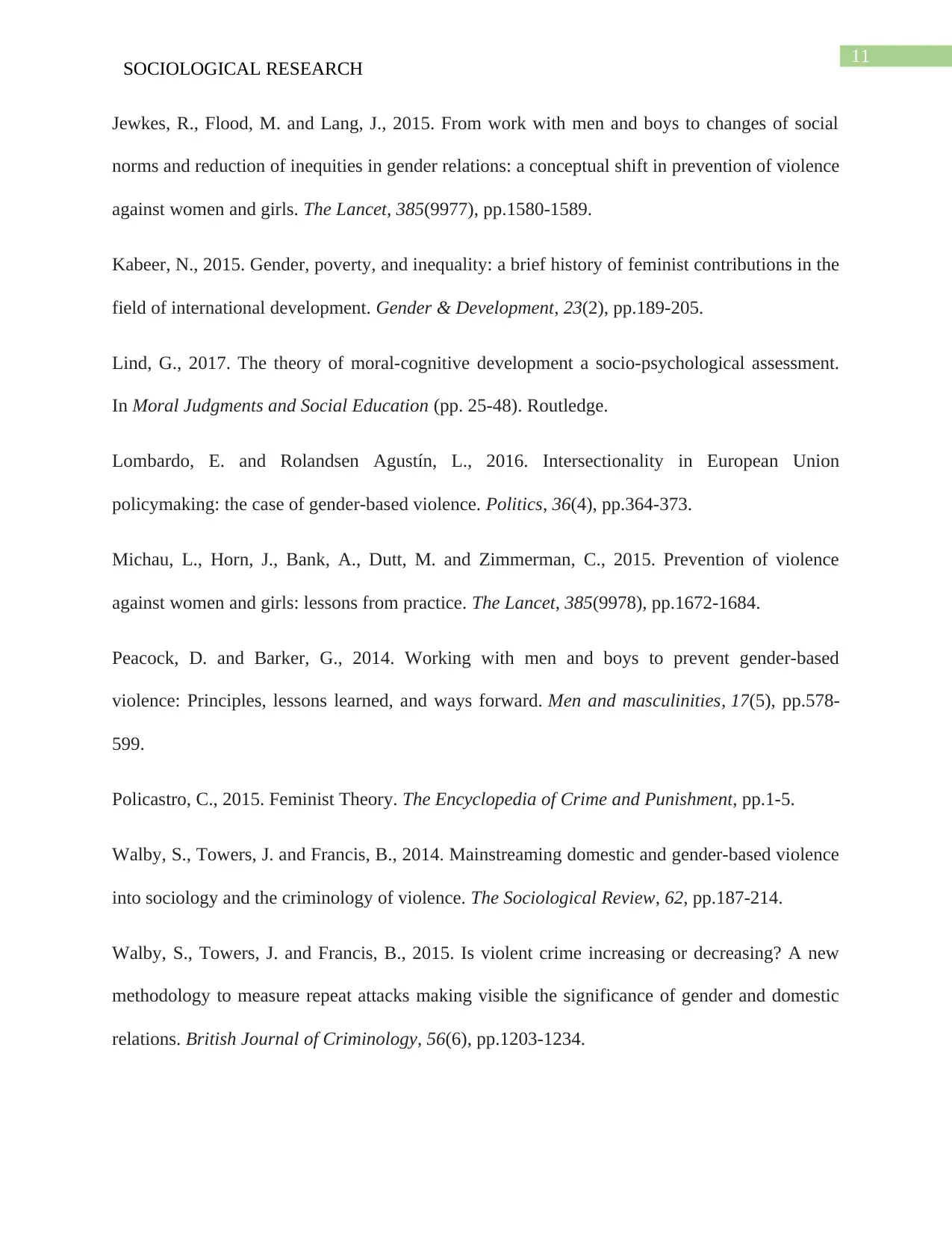
11
SOCIOLOGICAL RESEARCH
Jewkes, R., Flood, M. and Lang, J., 2015. From work with men and boys to changes of social
norms and reduction of inequities in gender relations: a conceptual shift in prevention of violence
against women and girls. The Lancet, 385(9977), pp.1580-1589.
Kabeer, N., 2015. Gender, poverty, and inequality: a brief history of feminist contributions in the
field of international development. Gender & Development, 23(2), pp.189-205.
Lind, G., 2017. The theory of moral-cognitive development a socio-psychological assessment.
In Moral Judgments and Social Education (pp. 25-48). Routledge.
Lombardo, E. and Rolandsen Agustín, L., 2016. Intersectionality in European Union
policymaking: the case of gender-based violence. Politics, 36(4), pp.364-373.
Michau, L., Horn, J., Bank, A., Dutt, M. and Zimmerman, C., 2015. Prevention of violence
against women and girls: lessons from practice. The Lancet, 385(9978), pp.1672-1684.
Peacock, D. and Barker, G., 2014. Working with men and boys to prevent gender-based
violence: Principles, lessons learned, and ways forward. Men and masculinities, 17(5), pp.578-
599.
Policastro, C., 2015. Feminist Theory. The Encyclopedia of Crime and Punishment, pp.1-5.
Walby, S., Towers, J. and Francis, B., 2014. Mainstreaming domestic and gender‐based violence
into sociology and the criminology of violence. The Sociological Review, 62, pp.187-214.
Walby, S., Towers, J. and Francis, B., 2015. Is violent crime increasing or decreasing? A new
methodology to measure repeat attacks making visible the significance of gender and domestic
relations. British Journal of Criminology, 56(6), pp.1203-1234.
SOCIOLOGICAL RESEARCH
Jewkes, R., Flood, M. and Lang, J., 2015. From work with men and boys to changes of social
norms and reduction of inequities in gender relations: a conceptual shift in prevention of violence
against women and girls. The Lancet, 385(9977), pp.1580-1589.
Kabeer, N., 2015. Gender, poverty, and inequality: a brief history of feminist contributions in the
field of international development. Gender & Development, 23(2), pp.189-205.
Lind, G., 2017. The theory of moral-cognitive development a socio-psychological assessment.
In Moral Judgments and Social Education (pp. 25-48). Routledge.
Lombardo, E. and Rolandsen Agustín, L., 2016. Intersectionality in European Union
policymaking: the case of gender-based violence. Politics, 36(4), pp.364-373.
Michau, L., Horn, J., Bank, A., Dutt, M. and Zimmerman, C., 2015. Prevention of violence
against women and girls: lessons from practice. The Lancet, 385(9978), pp.1672-1684.
Peacock, D. and Barker, G., 2014. Working with men and boys to prevent gender-based
violence: Principles, lessons learned, and ways forward. Men and masculinities, 17(5), pp.578-
599.
Policastro, C., 2015. Feminist Theory. The Encyclopedia of Crime and Punishment, pp.1-5.
Walby, S., Towers, J. and Francis, B., 2014. Mainstreaming domestic and gender‐based violence
into sociology and the criminology of violence. The Sociological Review, 62, pp.187-214.
Walby, S., Towers, J. and Francis, B., 2015. Is violent crime increasing or decreasing? A new
methodology to measure repeat attacks making visible the significance of gender and domestic
relations. British Journal of Criminology, 56(6), pp.1203-1234.
⊘ This is a preview!⊘
Do you want full access?
Subscribe today to unlock all pages.

Trusted by 1+ million students worldwide
1 out of 12
Related Documents
Your All-in-One AI-Powered Toolkit for Academic Success.
+13062052269
info@desklib.com
Available 24*7 on WhatsApp / Email
![[object Object]](/_next/static/media/star-bottom.7253800d.svg)
Unlock your academic potential
Copyright © 2020–2025 A2Z Services. All Rights Reserved. Developed and managed by ZUCOL.





